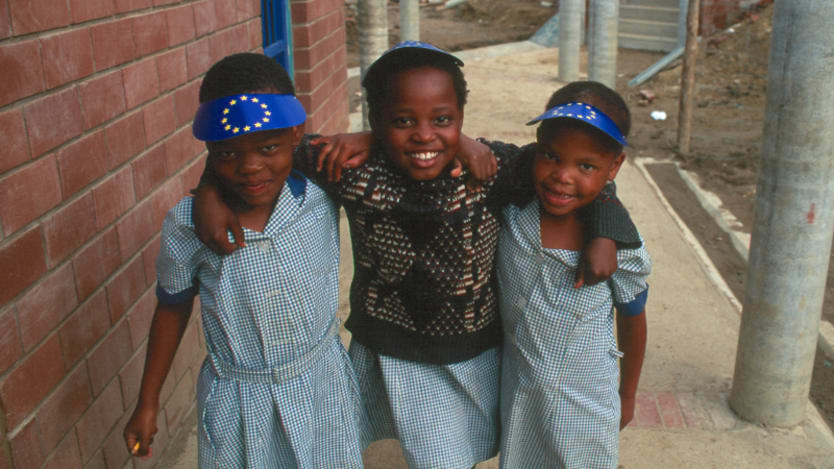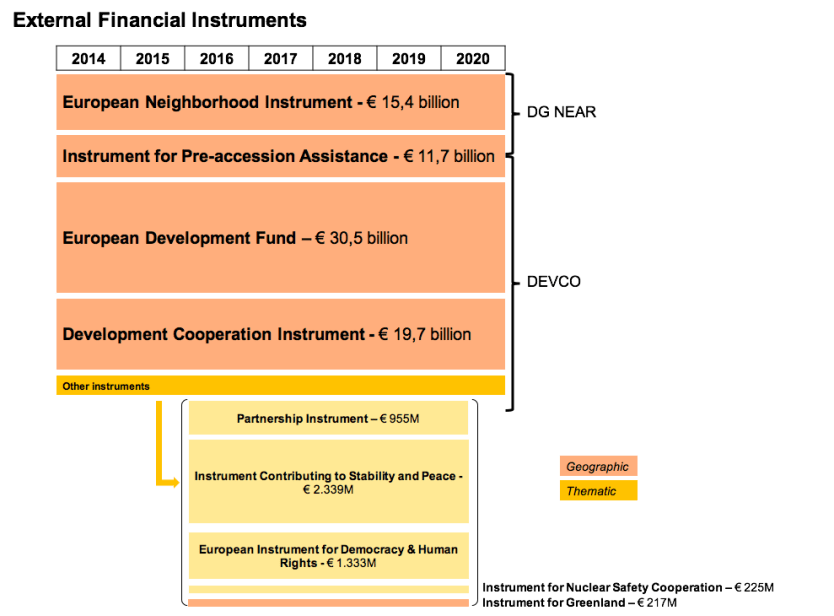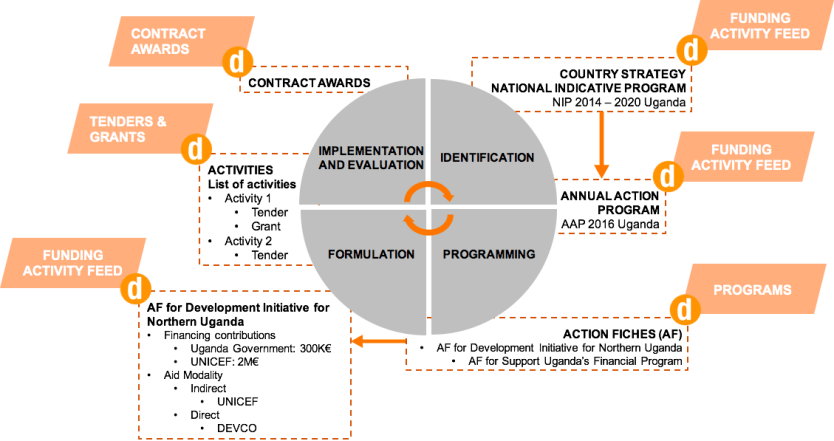
The European Union and its member states together make up the world’s largest donor of development funding, collectively providing 68 billion euros ($74 billion) of aid — more than half of global efforts — in 2015, according to OECD data.
A single EU institution, the European Commission, alone disbursed 10.3 billion euros ($11.2 billion) of development aid that year, money that was directed both toward recipient government budget support and specific projects.
These efforts enjoy high levels of support in Europe: About 68% of EU citizens believe development should be a priority for the EU, according to the latest Eurobarometer survey on aid.
Most of the money the Commission disburses is channeled through the Union’s aid agency, popularly known as EuropeAid. But what does EuropeAid do and how does it work? Here’s what you need to know.
What is EuropeAid?
EuropeAid’s full title is the Directorate General for International Development. It’s the European Commission agency responsible for designing European international cooperation and development policy and for delivering aid throughout the world. You might also see it referred to as DEVCO.
The agency works hand-in-hand with other European Commission departments involved in development work, including the Directorate General for Neighborhood Policy, or DG NEAR, European Civil Protection and Humanitarian Aid Operations, or ECHO, the European External Action Service, or EEAS, the Service for Foreign Policy Instruments, or FPI, and other European institutions such as the European Investment Bank, or EIB.
How much money is there and how is it disbursed?
The EU spending plan for the period 2014-2020 allocated over 66 billion euros ($72 billion) in 2017 terms to the external relations of the EU, most of which is administered by EuropeAid. In addition, EU member states contributed a further 30.5 billion euros ($33 billion) on a voluntary basis to the European Development Fund, or EDF, which brings the EU’s total allocation for external actions for the 2014-2020 spending period to more than 95 billion euros ($104 billion).
This funding is disbursed through External Financing Instruments, which can be thought of as geographic or thematic “budgets” to which EuropeAid can allocate its funding. Funds earmarked for a certain instrument can be allocated to programs within that instrument’s designated geography or theme, such as the European Neighborhood Instrument, which focuses on countries directly to the east and south of the EU; the European Instrument for Democracy and Human Rights, or EIDHR; or EDF itself, which focuses on Africa, the Caribbean and Pacific countries.
By the end of 2017, the European Commission must present the European Parliament and the Council with a mid-term review on these external financing instruments, which might affect the funding priorities up to 2020. These are the instruments up for review:

How does EuropeAid’s project cycle work, and where can I find the information I need?
As with most traditional development donor agencies, understanding the project cycle and studying planned projects ahead of time is key to success for organizations hoping to work with EuropeAid.
Its project cycle begins when the European Commission makes an agreement with a partner country about the priorities and focus of the Commission’s assistance, which is documented in a multi-annual “Country Strategy Paper and National Indicative Program.”
Afterwards, the EU Delegation to each partner country undertakes an initial assessment with the country’s government and other stakeholders to identify projects consistent with the agreed priorities. These projects are assembled into Annual Action Programs. Each AAP might include a number of “Action Fiches” — these are operational documents that specify how a project will be implemented and through which aid modality the budget will be disbursed.
The implementation stage is strongly defined by which “management mode” applies to the program. The management mode is the term used to describe the legal arrangement by which EU funds are channelled to the final recipients. The most common ones are direct management, where the European Commission — acting through its departments in Brussels, the EU Delegations or an executive agency — is the party managing the contract with the final recipient; and indirect management, where the final recipient receives EU funds through a contract agreed with an intermediary who has been entrusted by the Commission with budget implementation tasks — everything from running the procurement and grant award procedures preceding the conclusion of such contracts, including the award and rejection decisions, to managing the resulting contracts. The intermediary can be the partner country, an international organization, bilateral development agencies of EU member states and, exceptionally, a third donor country. They have margin of discretion to choose the procedure through which they will distribute the funds further, as far as they are similar to EU regulations. In all of these cases — both direct and indirect — the tenders and grants can be found through Devex as soon as they are public.
An example of how the EuropeAid project cycle might flow in Uganda is illustrated below. In the chart, you can also see the types of funding data that EuropeAid’s project cycle generates in the dotted orange boxes, and where to find that data on Devex in the solid orange boxes.

What types of grants and contracts does EuropeAid use?

Europeaid distributes its funds through budget support (transfer of funds), grants, and public contracts (tenders). Each of these types of support are structured according to specific regulations established in the Procurement And Grants, or PRAG practical guide.
A grant is a financial donation given to a beneficiary to contribute to the achievement of a policy objective by covering part of the functioning or project costs of the applicant. The EU only finances the part of the costs which are eligible for financing; the rest must be covered by the grantee or other funders. With a tender, the EU covers 100% of the costs of the purchase of services, goods or works and profit is allowed. EuropeAid has several tender procedures, depending on the type and value of the contract. The infographic below provides a basic guide through EuropeAid’s procurement process, detailing the different contract types.
The main difference between an open and a restricted tender is the application process. In a restricted call, the process is structured in two steps: First, an organization expresses interest or submits a concept note; then, shortlisted organizations are invited to submit a full proposal. The key goal of a concept note should be to highlight the relevance of your proposal, whereas a full proposal should focus more on project design. In an open procedure, both the concept note and the proposal are submitted at the same time.
Which organizations are eligible to apply for EuropeAid opportunities?
One of the big questions organizations face when interested in a EuropeAid grant or business opportunity is about eligibility. Generally speaking, EU external assistance is open to legal persons established in: An EU or European Economic Area member state; in the country directly benefiting from the funds; in developing countries as specified by the OECD Development Assistance Committee or, for the EDF, in any of the least developed countries as defined by the U.N.; and in other countries covered by a European Commission decision establishing reciprocal access to external aid.
However, the participation criteria might vary depending on the funding instrument to which the funds belong, so always check the eligibility criteria stated in the grant guidelines or procurement regulations.
Beyond basic eligibility, it is important for organization’s to be familiar with EU jargon and goals; to review the evaluation and selection criteria that the management agency will use; and to draft the proposal in cooperation with implementing partners and other stakeholders, such as local authorities and communities.
Don’t forget to use Devex’s Funding Activity Feed and program reports to become familiar with EU objectives in the programming stage and to plan ahead for Europeaid funding.
Want to learn more about EuropeAid funding priorities? Click here to read Devex’s exclusive analysis of 5.2 billion euros ($5.8 billion) worth of EuropeAid planned funding for 2016/17.








